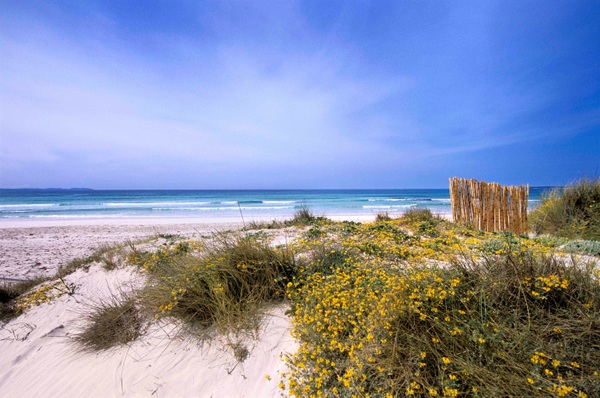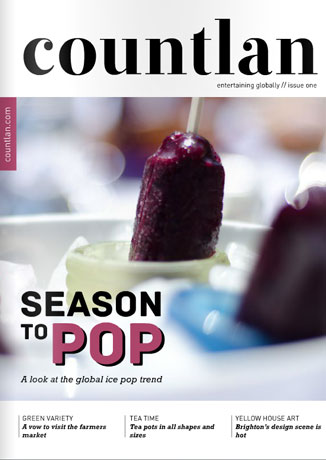
Salt Rising: Flor de Sal Des Trenc
On a trip to Mallorca in 2010, marketer, Oliver Backer visited the southern salt pans of the Spanish island and instantly fell in love. “I knew I had to get involved,” Backer shares; he is now the administrator at Flor de Sal d’Es Trenc, a company started by a young Swiss entrepreneur in 2003. Delicate salt crystals float to the top of pristine salt-fields uninterrupted by sea or air routes on this section of the coast. “Flor de Sal d’Es Trenc is special because of the way it is harvested and where it is formed. Our little corner of the island has rare qualities, which makes it perfect for the production of sea salt.
The salt fields in Mallorca are some of the oldest in the world, first used by the Phoenicians and Romans thousands of years ago.” In addition to natural sea salt, which has gained quite a reputation among foodies and chefs, the innovative decade old company is also known for its salt blends such as salt with hibiscus flowers or its most popular Mediterranea salt with rosemary, marjoram, thyme and oregano.
INTERVIEW: Oliver Backer, Administrator, Flor de Sal d’Es Trenc, Mallorca
01 How did you get involved with Flor de Sal d’Es Trenc?
Flor de Sal d’Es Trenc was founded by a young Swiss entrepreneur in the spring of 2003, making this year our 10th anniversary. Since then the company has evolved in all senses and is now a recognized brand by foodies all over the world, but we still strive to keep to our roots by providing a fully natural, 100% handmade product to our customers to ensure the highest of qualities. Before entering the salt business I worked in marketing, therefore it was most definitely a departure into something new. I can confidently say however that I have never enjoyed my work more than at Flor de Sal d’Es Trenc, and I couldn’t dream of a better place to live.
02 Why is salt from Mallorca special?
Flor de Sal d’Es Trenc is very special because of the way it is harvested, and where it is formed. Our little corner of the island has very rare qualities which make it perfect for the production of sea salts, so much so that the salt fields are one of the oldest in the world, first used by the Phoenicians and Romans thousands of years ago. The south-western corner of the island where the salt fields are located are a pristine natural environment protected by the European Union. There are no sea or air routes on this stretch of the coast line, and there is only a very mild current. This has allowed an almost tropical landscape to form, with crystal clear unpolluted water and long, white sandy beaches. Combining that with sun shine, the slight breeze which blows in from sea, and lots of patience we are able to create Flor de Sal of highest quality.
03 What is the difference between Mallorcan salt and other types of salt on the market?
As mentioned earlier, one of the main reasons for the outstanding quality of Mallorcan salt is the purity of the water from which is it formed. Another important aspect to consider is the way it is harvested and processed. Unlike common sea salts, nothing is extracted nor added to Flor de Sal dʼEs Trenc during the entire creation process. It is 100% hand-harvested, and only the purest and highest quality salt which floats on top of the water’s surface is collected and dried under the Mediterranean sun. It is thus a first class natural product. As it has been obtained through a careful process, Flor de Sal dʼEs Trenc not only retains all the aroma of the Mediterranean Sea, but also more than 80 minerals and trace elements. Its sodium chloride content, which is the main component of common salt, is however relatively low.
When the sun and the wind hit the salt flats, the magnesium contained in sea water is kept on the surface of the water. This is why Flor de Sal dʼEs Trenc contains between 16 and 20 times more magnesium than common sea salt. It also contains double the amount of minerals such as calcium and potassium, and even higher amounts of various trace elements. This unique mineral composition makes Flor de Sal an ideal ingredient for those concerned with their health; and the magnesium acts as a natural flavor enhancer, thus only needing small amounts to flavor your food. This frugal use of Flor de Sal dʼEs Trenc helps to reduce the intake of sodium chloride, fitting in with nutritionists’ recommendations. Gourmets value its balanced aroma and the smooth texture of its crystals. Given that it is a completely natural product Flor de Sal dʼEs Trenc is always slightly moist. The crystals melt in the mouth and turn even the simplest dishes into true culinary events.
04 You have a book, La Sal de Vida? What is that about?
La Sal de la Vida is our homage to Balearic and Spanish local cuisine. Together with a selection of the best chefs on Mallorca, we created a book which explains how to create local recipes, while also giving you insight into the world of salt and acting out as an excellent guide to the islands best restaurants. At the moment the book is only available in Spanish and German, but work is on its way to release it in English.
05 Is Flor de Sal d’Es Trenc considered a finishing salt or can you cook with it?
As the salt crystals we harvest are very delicate, we recommend to only use it as a finishing salt to be able to experience the full aroma and taste of our blends. However, there is much to be said on that topic as it touches into the very basics of how people cook, which is best portrayed in a simple example: If you are preparing a simple sauce to go with a meal for your family, chances are you will need to add a relatively large amount of table salt to it to be able to notice the taste of it on the finished plate. However, you could also prepare that same sauce without any salt at all, and once it is on the plate and ready to eat you sprinkle a small pinch of Flor de Sal d’Es Trenc onto it. The higher levels of magnesium will allow you to have exactly the same level of salinity you desired, with only having to actually consume less than half a gram of salt per meal.
06 What was the reason for producing flavoured sea salts?
Flor de Sal d’Es Trenc is a pioneer in blending Flor de Sal with different ingredients, creating a new way of not only enriching your dishes with the new flavors and spices, but also with the Flor de Sal itself. As the concept was non-existent at the time, there was a huge learning curve to overcome for anyone we presented the products to. As it is a finishing salt, we actively had to explain the benefits of changing the way you enhanced your food. Due to its incredible reception by some of the best chefs in the world, word of mouth let us expand the products with success into every continent.
07 What is the most popular flavour of salt you produce?
Flor de Sal d’Es Trenc Mediterránea is one of the most popular blends we currently produce. We think the reason for this is that the flavors it brings are so purely Mediterranean, that it gives a touch of Spain to every dish, which after all was our true goal.
08 Does salt have an “expiry” date?
As salt is a natural conservative, it is impossible to define its expiry date. If you look at all the different types of salt crystals and compositions available in the world, you will find some which are thousands of years old coming from deep within a mountain, to some like our Flor de Sal which, depending on when it is bought by our customers, can be as little as a few weeks old. Due to the relatively similar chemical compositions of salts, if stored correctly in a cool and dry spot, it will remain the same even though by law a fixed expiry date is necessary. However, in our blends we of course add different ingredients, which over time will lose some of their taste, aroma and colour and therefore need a stricter expiry date. We always produce our salt fresh for any order, which means that wherever you are obtaining it you can rest assured that it will always have the same burst of aroma on your dining table as when we put it into the tins by hand.
09 How do you serve salt to guests at home? Is it straight from the canister?
Everyone has their own personal preference. Some transfer the salts into their own small ceramic bowls or containers; I however always keep the salt inside the closed bag in the tin, and encourage everyone to open and serve it with their fingers. This allows them to feel the texture of the salt hands on, and also lets you season your dish to the exact point you want it. In any case, to conserve the quality of the blends I recommend storing it inside the tin.
10 What are some entertaining traditions in Mallorca?
Food is one of the main excuses for families and friends to come together in Spain, and there are countless traditional Mallorcan recipes for each season in the year. The sun, beach and nature are of course also enjoyed on a daily basis not only by tourists but also by the locals, along with the hundreds of traditional festivals, beautiful architecture, art, music… the Island is definitely an escape to paradise! I highly recommend the visit to any interested person, being only a short 20 minute flight from the beautiful yet buzzing city of Barcelona.
11 How can someone tell the quality of a salt?
That would depend on what type of quality you are looking for. Its chemical purity I’m afraid can only be seen with a lab test; however there are many ways to check what type of salt you are holding in your hand. Although they have very similar chemical compositions, the main difference in salts is how it crystallizes, which depending on that changes the way it looks and tastes completely. Flor de Sal is considered the purest and most natural salt in existence, therefore I’ll give you a few tips on how to make sure what you are holding is the real deal: Pour a decent amount of natural, unblended salt into the palm of your hand. Your palm should start feeling cold, and the Flor de Sal itself should have a very low density compared to table salt. Next, look at the crystals themselves. The grand majority should look like small flat petals, and there should never be any grains. They should be very brittle and have a low salinity, so if it’s too hard or it tastes too strong, it’s not Flor de Sal.
TIP: Use Your Fingers. While some serve salt out of a dish, serving salt with fingers gives the experience of feeling the grains.











